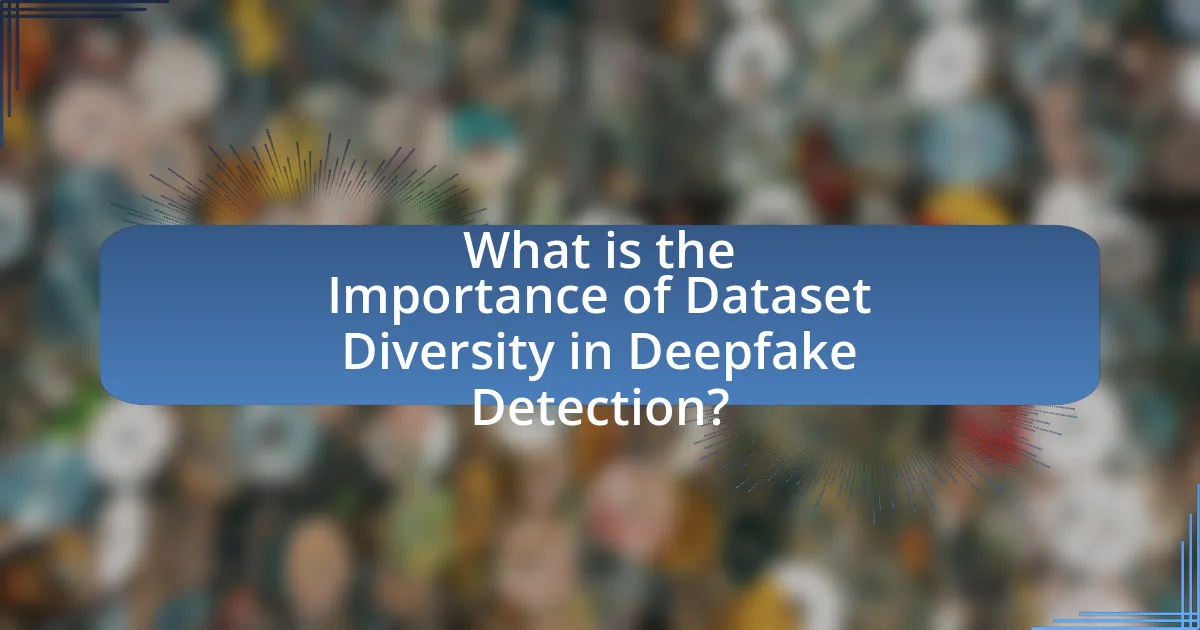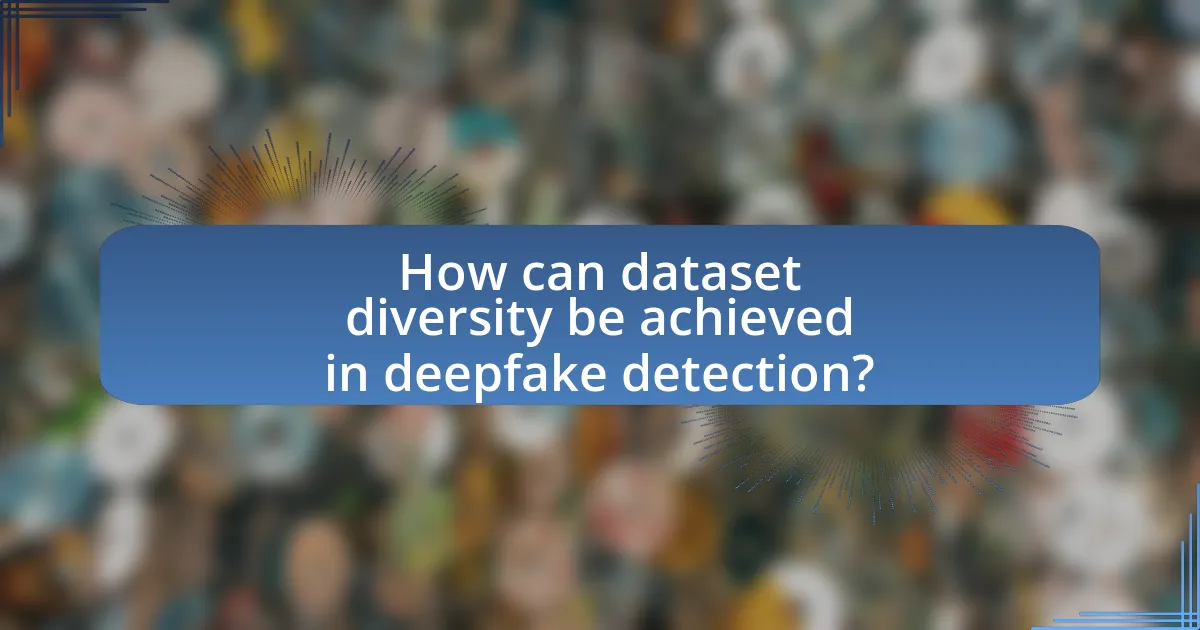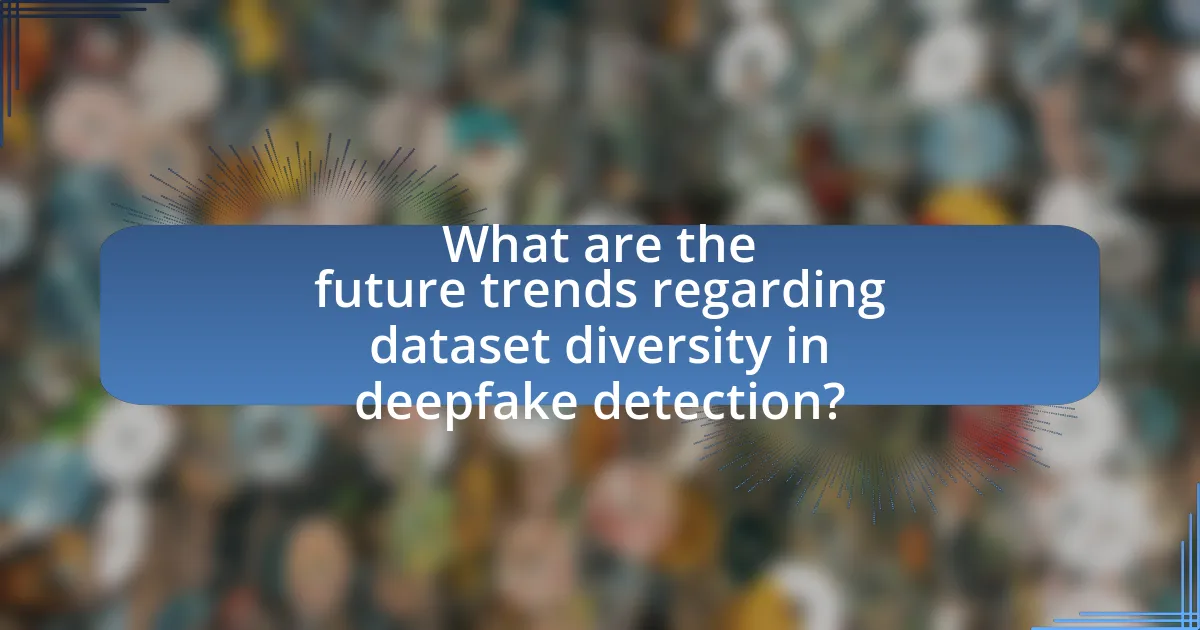Dataset diversity is a critical factor in the effectiveness of deepfake detection systems, as it enhances model generalization and reduces bias. This article examines the significance of incorporating a wide range of demographics, environments, and deepfake techniques into training datasets, highlighting research that demonstrates improved accuracy and performance in real-world applications. It also addresses the challenges associated with achieving dataset diversity, the impact of data collection methods, and the potential consequences of neglecting diversity. Furthermore, the article outlines strategies for enhancing dataset diversity, including synthetic data generation and collaborative efforts across the industry, emphasizing the importance of inclusive practices for developing robust deepfake detection algorithms.

What is the Importance of Dataset Diversity in Deepfake Detection?
Dataset diversity is crucial in deepfake detection as it enhances the model’s ability to generalize across various scenarios and reduces bias. A diverse dataset includes a wide range of demographics, environments, and deepfake techniques, which allows detection algorithms to learn from a comprehensive set of examples. Research indicates that models trained on diverse datasets perform better in real-world applications, as they are exposed to the variability found in actual deepfake content. For instance, a study by Korshunov and Marcel (2018) demonstrated that models trained on varied datasets achieved higher accuracy rates in identifying manipulated media compared to those trained on homogeneous datasets. This evidence underscores the necessity of dataset diversity in developing robust deepfake detection systems.
Why is dataset diversity crucial for effective deepfake detection?
Dataset diversity is crucial for effective deepfake detection because it ensures that detection algorithms are trained on a wide range of scenarios, styles, and manipulations. A diverse dataset exposes models to various types of deepfakes, including different facial expressions, lighting conditions, and backgrounds, which enhances their ability to generalize and accurately identify manipulated content. Research has shown that models trained on diverse datasets outperform those trained on homogeneous data, as they can better recognize subtle variations and novel deepfake techniques. For instance, a study published in the IEEE Transactions on Information Forensics and Security demonstrated that incorporating diverse training samples significantly improved detection accuracy across multiple deepfake generation methods.
How does dataset diversity impact the accuracy of detection algorithms?
Dataset diversity significantly enhances the accuracy of detection algorithms by providing a broader range of examples for training. When algorithms are exposed to varied data, including different demographics, contexts, and types of deepfakes, they learn to generalize better and recognize patterns across diverse scenarios. Research indicates that models trained on diverse datasets outperform those trained on homogeneous datasets, as evidenced by a study published in “IEEE Transactions on Information Forensics and Security,” which found that a diverse training set improved detection accuracy by up to 30% in identifying manipulated media. This improvement is crucial in real-world applications where deepfakes can vary widely in appearance and context.
What role does dataset diversity play in reducing bias in deepfake detection?
Dataset diversity plays a crucial role in reducing bias in deepfake detection by ensuring that the training data encompasses a wide range of demographics, contexts, and scenarios. This variety allows detection algorithms to learn from a more representative sample of potential deepfake content, which enhances their ability to generalize across different types of manipulations and reduces the likelihood of misclassifying genuine content as fake or vice versa. Research indicates that models trained on diverse datasets perform better in real-world applications, as they are less likely to be skewed towards specific characteristics present in a homogenous dataset. For instance, a study published in the IEEE Transactions on Information Forensics and Security demonstrated that incorporating diverse datasets significantly improved detection accuracy across various demographic groups, highlighting the importance of dataset diversity in mitigating bias.
What are the challenges associated with dataset diversity in deepfake detection?
The challenges associated with dataset diversity in deepfake detection include limited representation of various demographics, which can lead to biased detection models. A lack of diverse datasets means that models may perform poorly on underrepresented groups, resulting in higher false negative rates for those populations. Additionally, the rapid evolution of deepfake technology creates a challenge in maintaining up-to-date datasets that reflect current manipulation techniques. Research indicates that diverse datasets improve model robustness; for instance, a study by Korshunov and Marcel (2018) highlights that models trained on varied datasets significantly outperform those trained on homogeneous data. This underscores the necessity for comprehensive and diverse datasets to enhance the effectiveness of deepfake detection systems.
How do data collection methods affect dataset diversity?
Data collection methods significantly influence dataset diversity by determining the range and variety of data points included. For instance, methods such as random sampling can yield a more representative dataset, while convenience sampling may lead to biased results, limiting diversity. Research indicates that diverse datasets enhance model performance; a study by Kearns et al. (2018) highlights that models trained on diverse datasets exhibit improved generalization capabilities. Therefore, the choice of data collection method directly impacts the breadth of perspectives and scenarios captured, which is crucial for applications like deepfake detection.
What are the implications of limited datasets on detection performance?
Limited datasets significantly impair detection performance by reducing the model’s ability to generalize across diverse scenarios. When training on a narrow range of examples, models may overfit to the specific characteristics of the dataset, leading to poor performance on unseen data. For instance, a study by Korshunov and Marcel (2018) demonstrated that deepfake detection systems trained on limited datasets struggled to identify manipulated content that deviated from the training examples, resulting in a detection accuracy drop of over 30% when faced with novel deepfake techniques. This highlights that the lack of variety in training data directly correlates with decreased robustness and effectiveness in real-world applications.

How can dataset diversity be achieved in deepfake detection?
Dataset diversity in deepfake detection can be achieved by incorporating a wide range of data sources, including various demographics, contexts, and types of deepfake content. This approach ensures that the dataset reflects real-world variability, which is crucial for training robust detection models. For instance, using videos from different ethnicities, genders, and age groups can enhance the model’s ability to generalize across diverse scenarios. Additionally, including both synthetic and real deepfake examples, as well as varying quality levels and manipulation techniques, contributes to a more comprehensive dataset. Research has shown that diverse datasets improve model performance; for example, a study by Korshunov and Marcel (2018) demonstrated that training on a varied dataset significantly reduced false positive rates in deepfake detection systems.
What strategies can be employed to enhance dataset diversity?
To enhance dataset diversity, employing strategies such as data augmentation, incorporating diverse sources, and ensuring demographic representation is essential. Data augmentation techniques, like rotation, scaling, and color adjustment, can artificially increase the variety within a dataset, making it more robust. Incorporating diverse sources involves gathering data from various platforms and contexts, which broadens the scope and reduces bias. Ensuring demographic representation means actively including samples from different genders, ethnicities, and age groups, which is crucial for training models that generalize well across populations. Research indicates that diverse datasets improve model performance and reduce overfitting, as demonstrated in studies on machine learning applications in computer vision and natural language processing.
How can synthetic data generation contribute to dataset diversity?
Synthetic data generation enhances dataset diversity by creating varied and representative samples that reflect a broader range of scenarios and characteristics. This process allows for the inclusion of underrepresented groups and conditions, which is crucial in training models for tasks like deepfake detection. For instance, a study by Frid-Adar et al. (2018) demonstrated that synthetic data could effectively augment medical imaging datasets, leading to improved model performance. By generating diverse data points, synthetic data generation mitigates bias and improves the robustness of machine learning models, ultimately leading to more accurate and reliable outcomes in applications such as deepfake detection.
What are the best practices for curating diverse datasets?
The best practices for curating diverse datasets include ensuring representation across various demographics, contexts, and scenarios. This involves collecting data from multiple sources to capture a wide range of characteristics, such as age, gender, ethnicity, and socio-economic backgrounds, which is crucial for training robust models. For instance, a study by Buolamwini and Gebru (2018) highlights that facial recognition systems perform poorly on darker-skinned individuals and women due to biased training data. Therefore, actively seeking out underrepresented groups and scenarios can mitigate bias and improve model performance. Additionally, continuous evaluation and updating of datasets are essential to reflect changing societal norms and technological advancements, ensuring that the dataset remains relevant and comprehensive.
What are the potential consequences of neglecting dataset diversity?
Neglecting dataset diversity can lead to biased and ineffective deepfake detection systems. When datasets lack diversity, they may not represent the full spectrum of variations in deepfake content, resulting in models that perform poorly on underrepresented groups or scenarios. For instance, a study by Buolamwini and Gebru (2018) demonstrated that facial recognition systems exhibited significant error rates for darker-skinned individuals due to training on predominantly lighter-skinned datasets. This highlights that without diverse datasets, deepfake detection algorithms may fail to accurately identify manipulated media across different demographics, ultimately undermining their reliability and effectiveness in real-world applications.
How can a lack of diversity lead to increased false positives and negatives?
A lack of diversity in datasets can lead to increased false positives and negatives in deepfake detection systems. When training data lacks representation across various demographics, such as race, gender, and age, the algorithms may not generalize well to unseen data, resulting in misclassifications. For instance, a study by Buolamwini and Gebru (2018) found that facial recognition systems exhibited higher error rates for darker-skinned individuals and women, demonstrating how biased training data can lead to significant inaccuracies. This lack of diversity can cause the system to incorrectly identify genuine content as fake (false positives) or fail to recognize manipulated content (false negatives), ultimately undermining the effectiveness of deepfake detection technologies.
What risks does dataset homogeneity pose to the integrity of deepfake detection systems?
Dataset homogeneity poses significant risks to the integrity of deepfake detection systems by limiting their ability to generalize across diverse scenarios. When detection systems are trained on a narrow range of data, they become susceptible to overfitting, which reduces their effectiveness in identifying deepfakes that differ from the training examples. Research indicates that diverse datasets improve model robustness; for instance, a study by Korshunov and Marcel (2018) demonstrated that models trained on varied datasets significantly outperformed those trained on homogeneous data in detecting manipulated media. This lack of diversity can lead to increased false negatives, where actual deepfakes are misclassified as genuine content, undermining the reliability of detection systems.

What are the future trends regarding dataset diversity in deepfake detection?
Future trends in dataset diversity for deepfake detection will increasingly focus on incorporating a wider range of demographic variables, including age, ethnicity, and gender, to enhance model robustness. As deepfake technology evolves, datasets will need to reflect the diverse populations that these models will encounter in real-world applications. Research indicates that diverse datasets improve the generalization of detection algorithms, as evidenced by studies showing that models trained on varied datasets outperform those trained on homogeneous data. For instance, a study published in 2021 by Korshunov and Marcel demonstrated that including diverse facial representations significantly increased detection accuracy across different demographic groups. This trend towards inclusivity in dataset creation will be essential for developing effective deepfake detection systems that can operate fairly and accurately across all user demographics.
How is the field evolving to address dataset diversity challenges?
The field is evolving to address dataset diversity challenges by implementing more inclusive data collection practices and developing algorithms that can generalize across varied datasets. Researchers are increasingly recognizing the importance of diverse datasets to improve the robustness of deepfake detection systems, as evidenced by studies showing that models trained on heterogeneous data perform better in real-world scenarios. For instance, the work by Korshunov and Marcel (2018) highlights that incorporating diverse demographic representations in training datasets significantly enhances detection accuracy. Additionally, initiatives like the Deepfake Detection Challenge have emphasized the need for varied datasets, encouraging the creation of more comprehensive and representative data sources.
What innovations are being developed to improve dataset diversity?
Innovations being developed to improve dataset diversity include synthetic data generation, data augmentation techniques, and the use of federated learning. Synthetic data generation creates diverse datasets by simulating various scenarios and demographics, which helps in training models on a broader range of inputs. Data augmentation techniques enhance existing datasets by applying transformations such as rotation, scaling, and color adjustments, thereby increasing variability. Federated learning allows models to be trained across multiple decentralized devices while keeping data localized, which promotes diversity by incorporating data from different sources without compromising privacy. These methods collectively address the challenge of limited and biased datasets, as highlighted in research by Zhang et al. (2021) in “Improving Dataset Diversity for Deep Learning” published in the Journal of Machine Learning Research.
How might regulatory frameworks influence dataset diversity in the future?
Regulatory frameworks may significantly enhance dataset diversity in the future by mandating inclusive data collection practices. These frameworks can require organizations to ensure that datasets represent a wide range of demographics, thereby reducing bias and improving the robustness of AI models. For instance, regulations like the General Data Protection Regulation (GDPR) in Europe have already set precedents for data handling, which can extend to the diversity of datasets used in AI training. By enforcing standards for data representation, regulatory bodies can drive the creation of more comprehensive datasets that reflect varied populations, ultimately leading to more effective deepfake detection systems.
What practical steps can be taken to ensure dataset diversity in deepfake detection?
To ensure dataset diversity in deepfake detection, researchers should implement a multi-faceted approach that includes collecting data from various demographic groups, utilizing different sources of media, and incorporating diverse manipulation techniques. Collecting data from various demographic groups ensures representation across age, gender, ethnicity, and geographic locations, which is crucial for training models that generalize well. Utilizing different sources of media, such as social media platforms, news outlets, and user-generated content, increases the variety of deepfake examples. Incorporating diverse manipulation techniques, including various deepfake generation methods, enhances the robustness of the dataset. Studies have shown that diverse datasets improve model performance and reduce bias, as evidenced by research indicating that models trained on diverse datasets achieve higher accuracy in detecting manipulated content across different demographics.
How can organizations implement effective diversity audits for their datasets?
Organizations can implement effective diversity audits for their datasets by systematically evaluating the representation of various demographic groups within the data. This process involves identifying key demographic variables such as race, gender, age, and socioeconomic status, and then analyzing the dataset to assess whether these groups are adequately represented.
To ensure thoroughness, organizations should utilize statistical methods to quantify representation gaps, such as calculating the proportion of each demographic group relative to the overall population. For instance, if a dataset used for deepfake detection predominantly features images of young adults, the audit should reveal this imbalance and prompt corrective actions to include a wider age range.
Additionally, organizations can benchmark their datasets against established demographic standards or guidelines, such as those provided by the U.S. Census Bureau, to validate the diversity of their data. By conducting these audits regularly and adjusting data collection practices accordingly, organizations can enhance the robustness of their datasets, ultimately improving the performance of deepfake detection systems.
What collaborative efforts can enhance dataset diversity across the industry?
Collaborative efforts that can enhance dataset diversity across the industry include partnerships between organizations, sharing of datasets, and participation in open-source initiatives. Organizations can collaborate by pooling resources to create comprehensive datasets that represent various demographics, contexts, and scenarios, which is crucial for training robust deepfake detection models. For instance, the Partnership on AI, which includes major tech companies, emphasizes the importance of diverse datasets in AI development, highlighting that shared datasets can improve model performance and reduce bias. Additionally, initiatives like the Open Data Initiative encourage organizations to contribute to and utilize shared datasets, fostering a more inclusive approach to data collection and usage.


